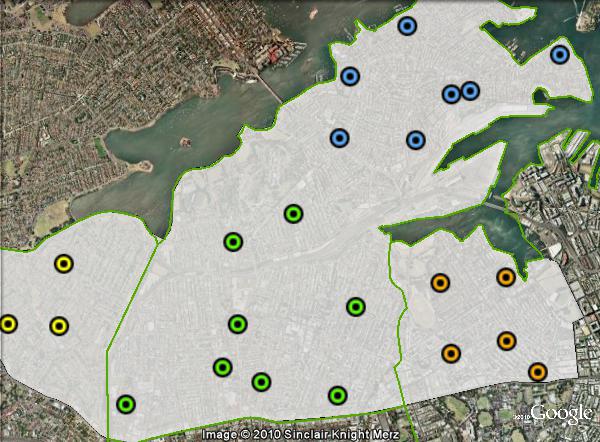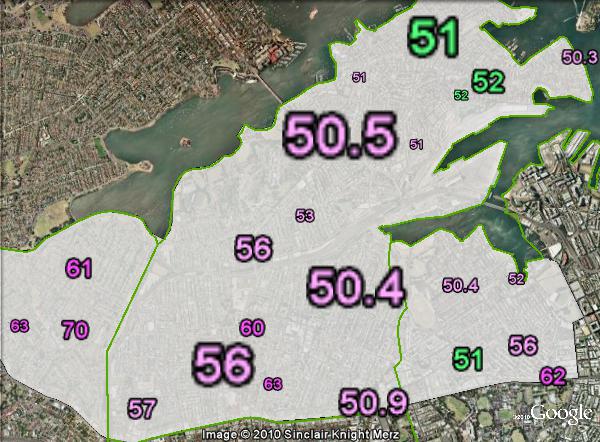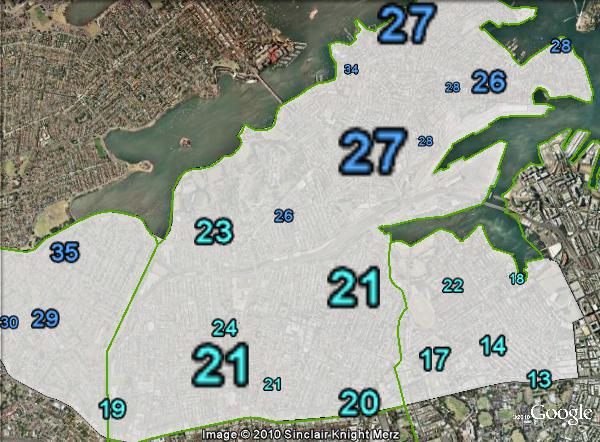ALP 3.7% vs GRN
Incumbent MP
Verity Firth, since 2007.
Geography
Inner Sydney. Balmain covers the entirety of Leichhardt local government area, including Balmain, Leichhardt, Lilyfield, Annandale and Rozelle, as well as Haberfield in the City of Ashfield and Glebe in the City of Sydney.
History
Balmain has existed as an electoral district in various forms since 1880. In that time it has covered a variety of different areas all around the Balmain peninsula. The original seat was created as a single-member district in 1880.
Back in the 19th century, districts would gain extra MPs if the population in the area grew, instead of experiencing regular redistributions. Balmain quickly gained extra MLAs, gaining a second in 1882, a third in 1885 and a fourth in 1889. Ironically the four-seat district of 1889 bore a close resemblance to the modern seat’s boundaries.
In 1894, Balmain was abolished and replaced by the single-member districts of South Balmain, North Balmain, Leichhardt and Annandale.
In 1904, Balmain was re-created when Balmain Southand Balmain Northwere merged. It elected a Liberal MP in 1904, but in 1907 it was won by the ALP’s John Storey in 1907. He had previously held Balmain Northfrom 1901 to 1904.
The NSW Labor Party split in 1916 over conscription, with most of the Holman government, including William Holman itself, expelled. Storey became leader of the remnants of the ALP in 1917.
In the lead-up to the 1920 election the seat of Balmain was expanded to cover parts of the neighbouring seats of Annandale, Camperdown, Darling Harbour, Glebe and Rozelle, and became a five-member district elected by proportional representation.
At the 1920 election, the expanded Balmain elected four Labor members and one Nationalist. The ALP won a slim majority, and Storey became Premier. He served until his death in 1921.
Balmain elected three Labor and two Nationalist MPs in 1922, and again elected four Labor members in 1925.
The 1927 election saw a return to single-member districts, and Balmain reduced to a smaller single-member district. At that year’s election, the official Labor candidate, Harry Doran, was challenged by sitting Labor MLA HV Evatt, who had been elected as a member for the multi-member Balmain district in 1925. Evatt won re-election as an independent Labor candidate.
In 1930, Evatt was appointed to the High Court and didn’t contest Balmain. John Quirk, whose neighbouring seat of Rozelle had been abolished in the redistribution, was elected in Balmain for the ALP. Evatt later went on to serve as a federal MP, federal minister, and leader of the federal ALP from 1951 to 1960.
Quirk died in 1938, and the 1939 Balmain by-election was won by his wife Mary. She held the seat until 1950, when she ran as an independent after losing Labor preselection. She lost to official Labor candidate John McMahon.
McMahon served as a minister in the Labor government from 1959 until the government lost power in 1965, and he retired in 1968.
Roger Degen held Balmain for the ALP from 1968 until his retirement in 1984. That year the seat was won by Peter Crawford.
In 1988, Crawford lost Balmain to former Olympic swimmer Dawn Fraser, running as an independent and ending over 80 years of Labor domination in Balmain.
Fraser held the seat for one term. In 1991, Balmain was abolished, and Fraser was defeated in an attempt to win the new seat of Port Jackson.
Port Jackson was won in 1991 by Sandra Nori of the ALP. Nori held the seat until 2007. In 2003, Port Jackson was the main target for the Greens, with Jamie Parker reducing Nori’s margin to 7.3%.
In 2007, Port Jackson was again renamed Balmain, and shifted west to lose Ultimo, Pyrmont and Sydney CBD and gained Haberfield. Nori retired, and the ALP preselected City of Sydney councillor Verity Firth. Greens councillor Rochelle Porteous reduced the ALP margin to 3.8%.
Candidates
- Verity Firth (Labor)
- Maire Sheehan (Independent)
- James Falk (Liberal)
- Leanne Gesling (Christian Democratic Party)
- Jane Ward (Independent)
- Nicholas Folkes (Independent)
- Jamie Parker (Greens)
- Jon Shapiro (Independent)
Political situation
Balmain is the strongest seat for the Greens in New South Wales. Despite a long history of ALP domination in the area, the Greens have made significant inroads in recent years. The Greens now hold six out of twelve seats on Leichhardt Council and have a strong presence with the inner western demographic that dominates Balmain and neighbouring Marrickville. When you also factor in the deep unpopularity of the Labor government, there is certainly a strong chance the Greens could win.
On the other hand, Firth has quite high popularity considering the state of the ALP, and could hold on to many voters who would otherwise consider voting Green.
2007 result
| Candidate | Party | Votes | % | Swing |
| Verity Firth | ALP | 16,562 | 39.2 | -2.9 |
| Rochelle Porteous | GRN | 12,471 | 29.5 | +0.2 |
| Peter Shmigel | LIB | 10,031 | 23.8 | +2.7 |
| Jane Ward | IND | 1,297 | 3.1 | +3.1 |
| Jane Hyde | IND | 987 | 2.3 | +2.3 |
| Edward Okulicz | DEM | 881 | 2.1 | -0.3 |
2007 two-candidate-preferred result
| Candidate | Party | Votes | % | Swing |
| Verity Firth | ALP | 17,933 | 53.8 | -3.2 |
| Rochelle Porteous | GRN | 15,431 | 46.2 | +3.2 |
Booth breakdown
Booths in Balmain have been divided into four areas. The bulk of the seat is contained in Leichhardt local government area, and the booths in that area have been divided between Balmain, covering the suburbs on the peninsula, and Leichhardt, covering the southern parts of the council area.
Booths in Ashfield council area have been grouped as Haberfield, and booths in the City of Sydney have been grouped as Glebe.
The Greens won a slim 50.4% majority in the Balmain area. The ALP won majorities of 54-55% in Leichhardt and Glebe, and a larger majority of almost 65% in Haberfield, boosted by a large 31% for the Liberal Party. The Liberals got 27% in Balmain, 21% in Leichhardt, and their lowest vote was 16% in Glebe.

| Voter group | Lib % | ALP 2PP % | Total votes | % of votes |
| Leichhardt | 21.6 | 54.9 | 13,705 | 32.5 |
| Balmain | 27.4 | 49.6 | 10,045 | 23.8 |
| Glebe | 16.4 | 53.9 | 6,166 | 14.6 |
| Haberfield | 31.8 | 64.7 | 3,622 | 8.6 |
| Other votes | 24.8 | 52.6 | 8,633 | 20.5 |




Apologies for this unexpected return to the fray, but @Roberto (on the Punch lie thread) asked about Maire Sheehan’s motives in standing in Balmain. I’m happy to cast some light on that.
No, Ms Sheehan, did not expect to win. When I asked her that she laughed, saying “Well that would be quite a surprise!” Like all the other candidates, she had political motives. She was primarily (as she clearly stated at the time) motivated out of concern with the Greens [1] only preference decision, and feared, as Ian Cohen did, that it would have negative consequences. She did not want to see that destructive decision vindicated by a lower house win in Balmian. At the time, the Greens were absolute favourites to romp in there.
It was stated (even here by commentators on this site who should know better) that she “gave preferences to Labor.” She did not.
When she announced, Mr Parker went on TV and “suggested” she was motivated by personal reasons (her DA rejection). That was also not the case. She was also called a “Labor stooge”. That is laughable. A friend of Mr Parker’s then made a determined effort to smear Ms Sheehan.
I was also contacted. The correspondence was pure malice. I hasten to add that none of smearing (apart for the DA suggestion) to my knowledge came from within Mr Parker’s campaign. However this person did write, “Jamie Parker knows that I intend to disclose… [the “truth about Sheehan’s motives]”
Apparently though he did not dissuade this person, who spread it widely with considerable enthusiasm. Perhaps Mr Parker should take care with his “friends”.
Ms Sheehan, like pretty well everyone else, did not anticipate the strength of the Liberal vote. That fact James Falk was in the lead at the final count meant that the Greens could win by coming second. Pretty well all of the Labor disaffection went over to the Libs. It did not go to the Greens, who barely increased (+1.2%) their primary margin in Balmain. I published just that prediction, with he Libs in front two weeks before the election. The exact proportions were a bit out, the order wasn’t. That earned a stern rebuke from Greens campaign management, who accused me of “wishful thinking”
That wasn’t the case, but whatever my thinking was, it was accurate.
It’s an interesting exercise to re-read the comments on this post, back to last year, and compare the predictions with the final result. I know I expressed surprise at the thought of Labor finishing third, and yet that’s what happened. Liberals finishing first on primaries was much less of a surprise.
The big swing was the 9.06% drop in the Labor primary vote, feeding into an 8.81% increase in the Liberal primary vote, with the Greens close to stationary on primary votes. Oddly enough, this was an identical pattern to 2007, except that the strength of the swing from Labor to Liberal was about three times greater this time.
A 1.19% increase in the Greens primary vote, to 30.72%; perhaps the earlier commenter who said the Greens ceiling was around the 30% mark was correct! On the other hand, the TPP swing to the Greens was a hefty 7.21%, albeit comparing ALP vs GNS in 2007 with GNS vs LIB in 2011.
Some impressive Liberal primary vote results: 51.22% at Dobroyd Point, 46.80% at St Oswald’s Haberfield, 41.52% Haberfield Public School. And lest it seem that the best Liberal results were all in the Haberfield corner of the electorate, how about Sydney Secondary College Balmain? 42.02% Liberal primary vote! I think it’s safe to say there’s never been a Liberal primary vote that high in the Balmain/Rozelle area.
Best wishes to Jamie Parker for the next four years. Given the general inaccuracy of comments two months out from this election, I won’t even try and guess what might happen in 2015…
I have no doubt, GNav – this is a Liberal seat from 2015. Quite apart from the fact that Parker is totally wedged into a role of absolute uselessness – and will be judged on that, there’s the demography… I have not been alone in bringing that up.
And yes, I will accused of flogging a dead horse and no doubt much worse, but tomorrow the LC preferences will be allocated… There was a lot of heat in the discussions here and elsewhere about the Punch’s “lie’ on Greens preferences in the LC.
“Penberthy is a habitual, professional liar” wrote the owner of this site, Ben Raue –friend of Jamie Parker. The owner of this site also wrote on March 26 in the “NSW 2011: results” thread, ” Maire Sheehan, a left-leaning independent who preferenced Labor…”
That is wrong. It’s not even a debating point. Ms Sheehan did not preference Labor.
This is not unimportant, or trivial.
The Demographic of this area is trending toward the Liberals, however this election could also be a high water mark for the Liberals
This seat still have a lot of inner city Greenies, who brough into the area, when it was cheap. As more houses changes hand, the people who can afford the house prices in this area now, are more likely to vote Liberal, Gradually the demographics will make this seats a Liberal Seat
However it might not happen in 2015, as this might be a high water mark of Liberal vote statewide, so it would not be surprising that the Liberals won’t improve on their primary at the next election
This was a high water mark election for the Liberals. At the next election Balmain will likely shift closer to Sydney, losing Haberfield, which will hinder the Liberals. While I do agree this area is trending towards the Liberals it is still also trending to the Greens.
Parker will have four years of incumbency in 2015, while Labor won’t be able to find anyone with the personal vote of Verity Firth. I would bet next time the Greens will be facing off against the Liberals, but the Liberals will find it harder after four years in government.
Ben, I would have thought that the Greens would be eagerly awaiting the next redistribution… All those surplus voters in Sydney, Heffron, Marrickville and Balmain means the seats will shift inwards.
The redistribution will reshape large parts of the city, could be interesting, particularly because some natural and long standing boundaries will have to be crossed to make up quotas.
“Trending to the Greens” … Well, Ben and many Tallyroomers (Millard etc) you are patient people. In 2003 Jamie Parker won 29% of the primary vote. This time, in conditions which couldn’t have been more favourable for him to pick up disenchanted Labor voters, he scored… Well you tell me, Ben. Or doesn’t his pathetic primary 2011 number fit your fanciful hopes?
The gains they made here were insignificant, barely measurable. The Greens vote in Balmain had its “high water mark” nearly a decade ago. Please, anyone who thinks otherwise, take a walk down Darling St on any weekend. Look at the retail, look at the customers. Look at the sea of grey hair. Look at the money. Look at the luxury cars fighting for the non-existent parking spaces. They’re hard to find not because there are more people living here (that’s not true, population is declining and aging). But because everyone, EVERYONE, doesn’t move anywhere except in their SUV.
And all those imagining that the rest of urban Australia will one day resemble the Greens 30% inner west heartland, all I’ll say is this: Get out of the ghetto.
And another thing… The Greens relatively high 2pp here came from Labor preferences in 2011. And that was after 4 years of Labor being demonised by Jamie Parker and his supporters. The Greens totally ignored their real opponents in this seat (The Liberals), preferring to turn thir most vicious attack dogs on their closest allies. Its highly unlikely that will happen again. After the Hanson debacle in the LC, I now wonder if the ALP will ever preference Greens again. and they most certainly won’t get them from the Libs. A line has been crossed by the NSW Greens, there will be no going back. No more “wins” after losing – as in Balmain.
PLUS this: Parker has had the advantage” of incumbency for years as Mayor. He is extremely well known, mostly for his constant negative message. It worked against him. His primary barely budged, despite a massive advertising push. Four more years will finish him.
This seat is Liberal in 2015.
Parker will be judged on his performance. Really, in regard to an election 4 years away, all we can do is speculate wildly at the moment. We’ll have a far better idea in a couple of years times.